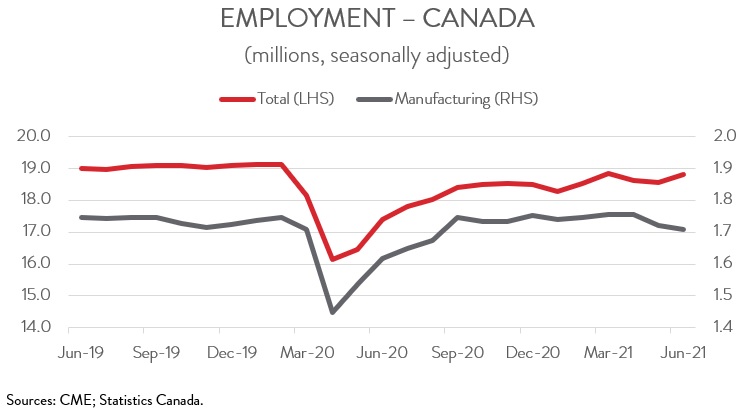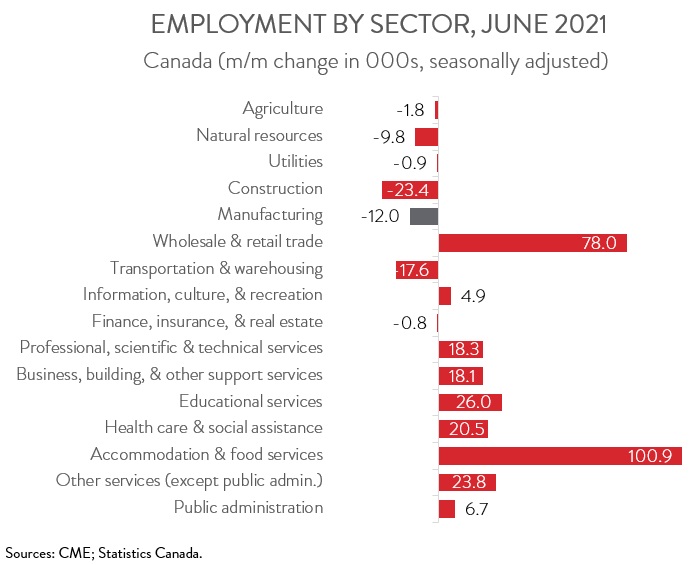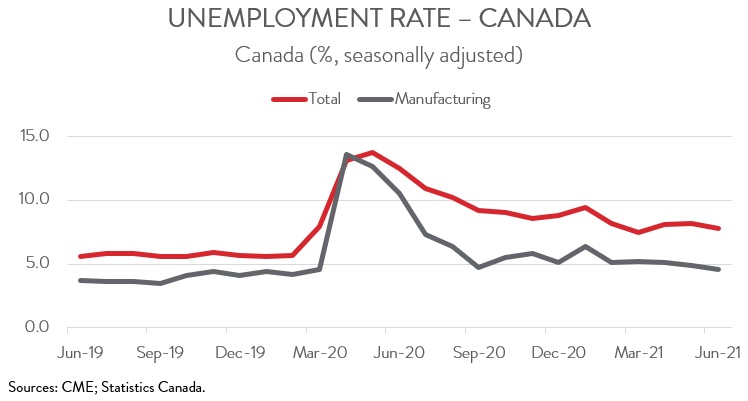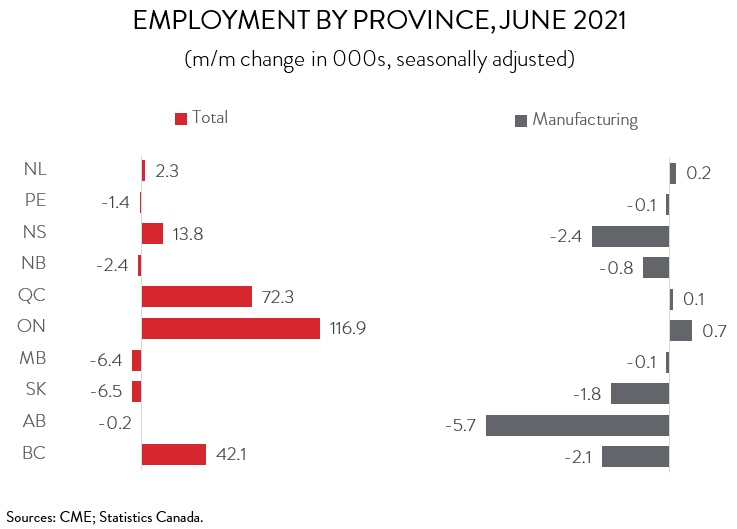Labour Market Trends
Labour Market Trends
JUNE 2021
Employment Rebounds as COVID-19 Restrictions Lift; Manufacturing Sheds Jobs for Second Straight Month
HIGHLIGHTS
- Employment rose by 230,700 (+1.2%) in June, largely offsetting the cumulative decline of 275,100 over the previous two months. Last month’s growth was entirely in part-time work and concentrated among youth.
- Employment was up in 9 of 16 major industries. All the gains were in the services sector, with those that rely on face-to-face interactions contributing the most to growth.
- Manufacturers shed 12,000 workers in June, adding to the 35,900 jobs lost in May.
- The unemployment rate fell from 8.2% in May to 7.8% in June.
- The job gains spanned 5 of 10 provinces, led by large increases in Ontario, Quebec and BC.
- The job market rebound in June was largely expected, as it coincided with several provinces rolling back public health restrictions in response to steadily declining COVID-19 cases and steadily rising vaccination rates. The pace of hiring is expected to remain strong over the summer months, as the economy reopens more fully and as health concerns diminish.
ECONOMY ADDS 230,700 JOBS IN JUNE
Employment rose by 230,700 (+1.2%) in June, largely offsetting the cumulative decline of 275,100 over the previous two months. Last month’s growth was entirely in part-time work and concentrated among youth aged 15 to 24, primarily young women. The increase in June left employment 340,400 or 1.8% below the pre-pandemic level.

The job market rebound in June was largely expected, as it coincided with several provinces rolling back public health restrictions in response to steadily declining COVID-19 cases and steadily rising vaccination rates. The pace of hiring is expected to remain strong over the summer months, as the economy reopens more fully and as health concerns diminish.
HIGH-CONTACT SERVICES SEE BIG JUMP IN EMPLOYMENT
Employment was up in 9 of 16 major industries. All the gains were in the services sector (+278,600), with those that rely on face-to-face interactions contributing the most to growth. Accommodation and food services added the most jobs in June, with employment up 100,900. This was followed by retail trade, which added 75,000 workers to payrolls. At the same time, other services, which includes establishments primarily engaged in providing personal care services like hairstylists, created 23,800 positions. However, despite this strong growth, the hospitality sector remains the furthest away from a full recovery.
Notable job gains were also recorded in educational services (+26,000) and in health care and social assistance (+20,500). As observed by Statistics Canada, the increase in health care and social assistance brought employment in this sector above the pre-pandemic level for the first time.

In contrast, employment in the goods-producing industries declined by 48,000 in June. Manufacturing employment was down for the second consecutive month. Following a decline of 35,900 in May, manufacturing employment fell a further 12,000 in June. Accordingly, after having recouped all its COVID-19 job losses in September 2020, employment in the sector is now 39,600 or 2.3% below this benchmark.
Employment in the construction industry fell by 23,400 in June, with most of the drop attributable to a decline in the number of self-employed workers in the sector. Employment was also down in natural resources (-9,800) and in agriculture (-1,800).
UNEMPLOYMENT RATE FALLS 0.4 PERCENTAGE POINTS
The unemployment rate fell from 8.2% in May to 7.8% in June. While the jobless rate remains well above the February 2020 rate of 5.7%, it is considerably lower than the record high of 13.7% in May 2020.
The unemployment rate in the manufacturing sector also fell last month, declining from 4.9% in May to 4.6% in June, down for the third consecutive month. Although this decline implies that the manufacturing labour market is tightening, it has yet to be reflected in the wage data. In June, the average hourly wage rate in manufacturing was up 0.6% month-over-month but down 0.6% year-over-year.

JOB GAINS CONCENTRATED IN ONTARIO, QUEBEC AND BC
The job gains spanned 5 of 10 provinces. Ontario added the most jobs in June, with employment rising 116,900. This was followed by Quebec, which added 72,300 jobs, and BC, which created 42,100 positions. The other notable increase was in Nova Scotia, where employment rebounded by 13,800 in June after declining by 22,200 in May. On the negative side, significant declines were recorded in Saskatchewan (-6,500), Manitoba (-6,400), and PEI (-1,400).
In the manufacturing sector, the drop in employment was concentrated in Western Canada. Alberta shed 5,700 manufacturing jobs in June, the first decline in four months. At the same time, manufacturers reduced payrolls by 2,100 in BC and by 1,800 in Saskatchewan. Turning to other regions, Nova Scotia’s manufacturing workforce also had a tough month in June, with employment falling by 2,400. There was little change in manufacturing employment elsewhere.
